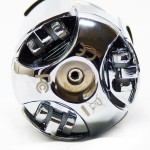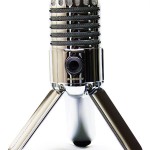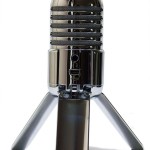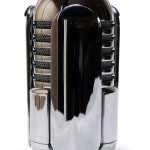Samson Meteor Podcast Microphone Review
It’s been a while since I’ve laid my hands upon any shiny audio gear, actually it’s been a while since I’ve done much of anything when it comes to Gadgetoid but I digress. Few things, it would seem, come shinier than the Samson Meteor mic, which looks like a 1950s take on a Portal (the game) Turret. If that means nothing to you, then think 1950s, chrome microphone.
With its beautiful vintage aesthetic, ruthless dedication to chrome and unique folding tripod leg design the Samson Meteor certainly makes an effort to set itself aside from the wealth of USB Microphone competition. These microphones are generally geared towards podcasting and amateur audio recording, and more and more high-end entrants seem to be seeing the light of day and struggling for their share of attention.
But the market is there. If you want to set yourself apart from the sheer number of people making their own little audio-visual contributions to the internet, it’s necessary to aim for clean, crisp vocals and a bit more of a professional polish. This means dropping up to £100 on a condenser mic, and learning to speak confidently… Sadly I can’t help too much with the latter, but there’s plenty of guidance out there.
So, how does the Samson Meteor stack up? Well, it’s a mixed bag. When it comes to portability it scores highly, coming with a carry bag, a highly flexible, lightweight USB cable and, of course, the folding legs. It tucks away into a comfortably palm-sized affair with the USB port and 3.5mm headphone jack tucked safely behind the rear leg.
Unlike a professional microphone basket, however, the three metal legs really don’t lend themselves well to isolating mouse-click and keyboard sounds from your microphone. The thin, rubber feet at the bottom of each leg do little to mitigate this. If you’re not mousing around whilst recording, and don’t have a laptop on your desk, you should be fine and will get good results from the Samson. If you’ve got a noisy desk, however, you’ll need to investigate an alternate microphone stand which will make those legs look awfully superfluous. Laptop or computer fan noise isn’t too much of a problem, your recording software should be able to handle noise reduction, and a noise gate makes a massive difference- totally cutting off the microphone when you’re not speaking or are quiet. You must be aware that getting the best results out of microphones like the Samson isn’t a plug and play affair, you’re going to need the software to back it up.
On the hardware front, Despite being touted as a compact, all-in-one solution the Samson Meteor benefits massively from at least a pop filter. Sitting it directly upon a desk, with a pop-filter connected to the rear leg was how I did most of the vocal testing, and a couple of solid hours dialogue later the Samson had produced some extremely satisfactory results for a tutorial video which my wife wanted to record.
Using nothing but the iMovie “Voice Over” feature and its noise cancelling function, the Samson perched upon a desk and a pop screen the vocal results were clean, crisp, noise free and sounded beautifully professional. I’d link the video, but I don’t think my wife is ready to become an overnight voice-over sensation yet.
If you happen to have a goose neck stand knocking about (they’re cheap and cheerful, although not particularly good quality from Maplin) then you’ll find the screw-thread in the bottom of the Samson Meteor Microphone incredibly handy. In a jiffy you can screw it onto the end of your stand and have a much more flexible range of microphone positioning. Noise isolation aside, however, I really don’t think the Samson benefits much from this, unless you have a particularly low desk. The hunched-over-the-microphone position may be the default for most discerning speakers, but it’s not strictly necessary to get close and personal with the Samson. Putting some distance between you and it, not to mention not speaking directly into it, will certainly help reduce pops on sibilant sounds. (This is no substitute for a pop screen, though!)
I tested the Samson Meteor with both the iPad 1 and 2 and can report that it works with both. I used Garageband to monitor and record audio, with great results in both cases. On the iPad 2 the Samson did, at first, have a weakly lit LED and was not detected. Firing up Garageband seemed to fix this. I believe this is a change to iOS 4.3 (rather than something specific to the iPad 2 itself) which severely limits USB power to connected devices, evidently until the OS deems it fit to supply power to things like USB microphones. It could also be a loose connection between the iPad 2 and the USB adaptor… The iPad 2s dock connector is a strange, curved affair which could easily introduce such problems. This wont affect normal use of the Samson, however, and after firing up Garageband and getting the microphone up and running, I could use the audio-out and microphone working in other applications with no problems.
This leads me onto one final thing, which I’ve skirted over until now. The Samson has a 3.5mm headphone port which can be used to monitor audio directly from the microphone, even when the application you’re using doesn’t explicitly do it for you. The monitor volume is extremely low, however, so it’s no substitute for your usual monitoring setup, but handy to let you know that the microphone is picking up. The main benefit of the headphone port is that it provides an audio output, you can use this audio out in lieu of your normal headphone output, giving a convenient and accessible place to connect your headphones, not to mention a good quality audio output which is isolated from your computers internals. The Samson Meteor also has a pretty significant volume advantage over the raw iPad output, too, and will drive my ‘phones to dangerous, painful levels. You’ll also be happy to know that the USB connector, and 3.5mm input are space sufficiently far enough apart to birth even bulky headphone connectors, such as those with a screw-off quarter inch jack adaptor. I tried both my Roland RH-300 headphones and the Sennheiser HD280 PRO headphones with the Samson Meteor- these have the biggest connectors I could find.
The Samson is a great alternative to the hassle and cabling chaos of XLR microphones, although it’s unlikely that its target market of podcasters and hobbyists/amateurs would consider these. Ultimately, though, the only reason to pick up the Samson over its competition is its sheer good looks and quirky stand style and decent audio-output. If you like the look of the Samson Meteor, enough to justify its ~£90 price tag, then you will not be disappointed.




